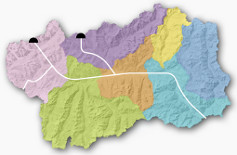The lower Aosta Valley and its castles
How: by car.
Recommended duration: two days.
Recommended period: all year round.
Distance: about 21 km.
A journey to discover the castles and some charming villages of the Lower Aosta Valley.
The Aosta Valley is famous for its many castles, testimony to a particularly rich and intense history.
The itinerary starts at Pont-Saint-Martin, which is the first village we meet when entering the Aosta Valley. Worthy of a visit is the Roman bridge, 36.65 metres long and 5.82 metres wide, dating back to the 1st century B.C. In February, the village holds a historic carnival that re-enacts the ancient legend of the ‘Devil’s Bridge’ and that of the ‘Nymph of the Lys river’, with the historical events that witnessed the conflict between the Salassi and the Romans to gain possession of the region. Going up in the direction of Perloz, we reach the old cemetery of Fontaney with the annexed chapel, built by Baron Pierre de Vallaise at the end of the 16th century as a scale reproduction of Aosta cathedral. Along the same road stands the elegant Baraing Castle, built at the end of the 19th century in neo-Gothic style and recently restored; it is currently the headquarters of the Mountain Community. Going on for about a kilometre, after the park area Bousc-daré, visitors can admire the ruins of Pont-Saint-Martin Castle, also known as Castellaccio or Castello vecchio (Old Castle), with an original keep (donjon) dating back to the 11th century, and subsequent additions and reconstructions that can be dated to between the 13th and 14th centuries.
Further along the route, we find Bard, home to an imposing fort that dates back to 1034. The fort is one of the main examples of military architecture in the Aosta Valley and occupies the whole of the Bard rock.
It played an important role during the French invasion in 1704 and in 1800. During the last attack Napoleon Bonaparte and his army were held back here for about a week. The Fort is open all year round and hosts exhibitions and events. It is also home to the Museum of the Alps.
The hamlet of Bard is a typical village that arose along this Roman road. It still keeps its medieval urban layout even today, and conserves fine residential buildings of the 15th-16th century, such as Challant House, with decorative and architectural details similar to those of Issogne Castle; Sot House; Sundial House, Bishop’s House; and Valperga House. Of particular note is the elegant eighteenth-century building of the noble family Nicole, the last counts of Bard.
Moving on towards Aosta, after about 5 km we reach Arnad, where visitors can admire a beautiful church in Lombard Romanesque style , which has been the property of the Benedictines of the Abbey of Fruttuaria since 1019. The church was destroyed by a terrible flood in 1408 and restored in 1500. The earlier parish, dating back to the 11th century and dedicated to Saint Germanus of Auxerre, must have stood a little to the south-east of the current building and was razed to the ground by a terrible flood in the same century. Of note are the Gothic cross vaults, the fifteenth-century entrance portal and the exterior frescoes; the collection of Late Gothic frescoes in the attic of the left nave, attributable to the so-called ‘Master of Arnad’ are also of notable interest. In addition to its church, Arnad is also famous for its delicious cured pork fat known as lardo an ideal accompaniment to the local wine Arnad-Montjovet. On special occasions it is possible to visit the Vallaise Castle of Arnad, also called the lower castle of Arnad or “Palais de La Costetta”. The castle is a magnificient aristocratic residence that today boasts a seventeenth century aspect, but actually dates much further back in history (indeed, the first core of the building - a fortified house - dates back to the 14th century). (for special openings, please contact the Tourist Office). Furthermore, a pleasant walk from Vallaise Castle leads to the Sanctuary of Machaby, dedicated to Our Lady of the Snows. The sanctuary’s origins would seem to date back to the fourteenth century.
Continuing down the trunk road, we shortly reach *Verrès*- the ancient Vitricium which is dominated by the imposing castle built between 1361 and 1390 by Ibleto di Challant on the ruins of an old fortress. The foundation of the convent of Saint-Giles (Sant’Egidio) dates back to the High Middle Ages, according to tradition in 912, whose canons, headed by a provost - hence the name of Provostship given to the institution - lived in the community following, at least from the beginning of the thirteenth century, the rule of Saint Augustine. The building of the Provostship, which underwent several alterations up until the end of the 18th century, conserves a dominant late Gothic stamp and along with the castle, still characterises the hamlet to this day. The Provostship immediately acquired economic power thanks to the benefits and parishes that were bestowed upon it by bishops and Popes, in addition to donations of the faithful. It thus became a centre of attraction for people of the surrounding area and contributed to the population and development of the hamlet, which was to gain an increasingly important role, triggered by the economic and social renewal that was happening all over Europe at the beginning of the second millenium of the Christian era. This important role was also of a strategic nature for the control of transit in the central valley of the Dora river and in the lateral valley of the Evançon river. During the carnival the village relives the feasts of the noble house of the Challant family: for three days there are dancing evenings, festive historical reenactments and the representation of the play ‘Una partita a scacchi’(A game of chess) by Giuseppe Giacosa.
At only 2 km from Verrès, at Issogne, stands another splendid castle, whose refined appearance is the result of the intervention commissioned by Prior Giorgio di Challant in the last two decades of the 15th century. The following are especially noteworthy: the famous fountain of the pomegranate tree in wrought-iron, the paintings of the entrance hall and porch reproducing scenes of everyday life in the fifteenth century, the magnificent baronial hall adorned with wall paintings and the chapel. The castle is open to the public all year round.













